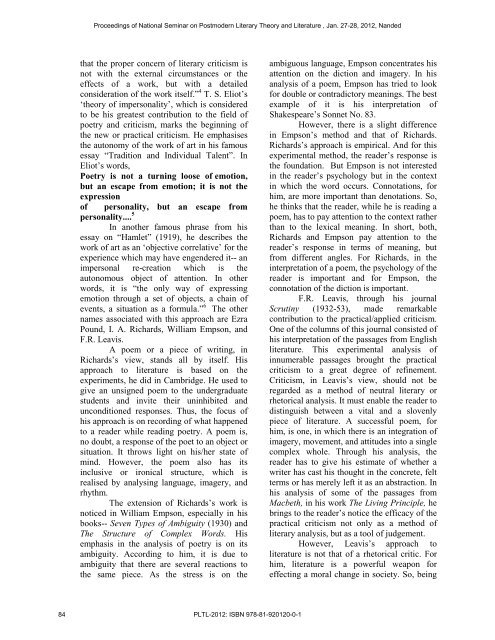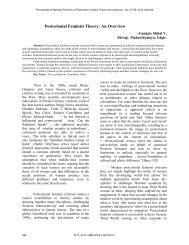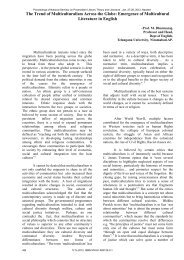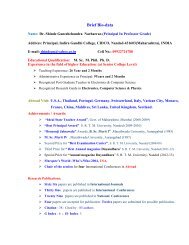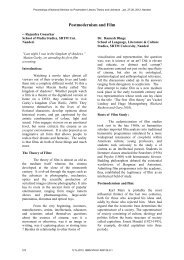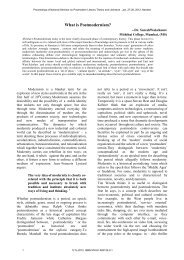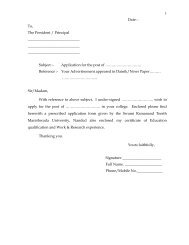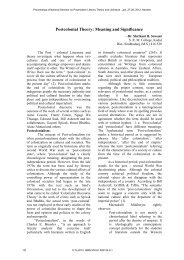Post-Structuralism: An Indian Preview - Igcollege.org
Post-Structuralism: An Indian Preview - Igcollege.org
Post-Structuralism: An Indian Preview - Igcollege.org
You also want an ePaper? Increase the reach of your titles
YUMPU automatically turns print PDFs into web optimized ePapers that Google loves.
Proceedings of National Seminar on <strong>Post</strong>modern Literary Theory and Literature , Jan. 27-28, 2012, Nanded<br />
that the proper concern of literary criticism is<br />
not with the external circumstances or the<br />
effects of a work, but with a detailed<br />
consideration of the work itself.” 4 T. S. Eliot’s<br />
‘theory of impersonality’, which is considered<br />
to be his greatest contribution to the field of<br />
poetry and criticism, marks the beginning of<br />
the new or practical criticism. He emphasises<br />
the autonomy of the work of art in his famous<br />
essay “Tradition and Individual Talent”. In<br />
Eliot’s words,<br />
Poetry is not a turning loose of emotion,<br />
but an escape from emotion; it is not the<br />
expression<br />
of personality, but an escape from<br />
personality.... 5<br />
In another famous phrase from his<br />
essay on “Hamlet” (1919), he describes the<br />
work of art as an ‘objective correlative’ for the<br />
experience which may have engendered it-- an<br />
impersonal re-creation which is the<br />
autonomous object of attention. In other<br />
words, it is “the only way of expressing<br />
emotion through a set of objects, a chain of<br />
events, a situation as a formula.” 6 The other<br />
names associated with this approach are Ezra<br />
Pound, I. A. Richards, William Empson, and<br />
F.R. Leavis.<br />
A poem or a piece of writing, in<br />
Richards’s view, stands all by itself. His<br />
approach to literature is based on the<br />
experiments, he did in Cambridge. He used to<br />
give an unsigned poem to the undergraduate<br />
students and invite their uninhibited and<br />
unconditioned responses. Thus, the focus of<br />
his approach is on recording of what happened<br />
to a reader while reading poetry. A poem is,<br />
no doubt, a response of the poet to an object or<br />
situation. It throws light on his/her state of<br />
mind. However, the poem also has its<br />
inclusive or ironical structure, which is<br />
realised by analysing language, imagery, and<br />
rhythm.<br />
The extension of Richards’s work is<br />
noticed in William Empson, especially in his<br />
books-- Seven Types of Ambiguity (1930) and<br />
The Structure of Complex Words. His<br />
emphasis in the analysis of poetry is on its<br />
ambiguity. According to him, it is due to<br />
ambiguity that there are several reactions to<br />
the same piece. As the stress is on the<br />
ambiguous language, Empson concentrates his<br />
attention on the diction and imagery. In his<br />
analysis of a poem, Empson has tried to look<br />
for double or contradictory meanings. The best<br />
example of it is his interpretation of<br />
Shakespeare’s Sonnet No. 83.<br />
However, there is a slight difference<br />
in Empson’s method and that of Richards.<br />
Richards’s approach is empirical. <strong>An</strong>d for this<br />
experimental method, the reader’s response is<br />
the foundation. But Empson is not interested<br />
in the reader’s psychology but in the context<br />
in which the word occurs. Connotations, for<br />
him, are more important than denotations. So,<br />
he thinks that the reader, while he is reading a<br />
poem, has to pay attention to the context rather<br />
than to the lexical meaning. In short, both,<br />
Richards and Empson pay attention to the<br />
reader’s response in terms of meaning, but<br />
from different angles. For Richards, in the<br />
interpretation of a poem, the psychology of the<br />
reader is important and for Empson, the<br />
connotation of the diction is important.<br />
F.R. Leavis, through his journal<br />
Scrutiny (1932-53), made remarkable<br />
contribution to the practical/applied criticism.<br />
One of the columns of this journal consisted of<br />
his interpretation of the passages from English<br />
literature. This experimental analysis of<br />
innumerable passages brought the practical<br />
criticism to a great degree of refinement.<br />
Criticism, in Leavis’s view, should not be<br />
regarded as a method of neutral literary or<br />
rhetorical analysis. It must enable the reader to<br />
distinguish between a vital and a slovenly<br />
piece of literature. A successful poem, for<br />
him, is one, in which there is an integration of<br />
imagery, movement, and attitudes into a single<br />
complex whole. Through his analysis, the<br />
reader has to give his estimate of whether a<br />
writer has cast his thought in the concrete, felt<br />
terms or has merely left it as an abstraction. In<br />
his analysis of some of the passages from<br />
Macbeth, in his work The Living Principle, he<br />
brings to the reader’s notice the efficacy of the<br />
practical criticism not only as a method of<br />
literary analysis, but as a tool of judgement.<br />
However, Leavis’s approach to<br />
literature is not that of a rhetorical critic. For<br />
him, literature is a powerful weapon for<br />
effecting a moral change in society. So, being<br />
84 PLTL-2012: ISBN 978-81-920120-0-1


